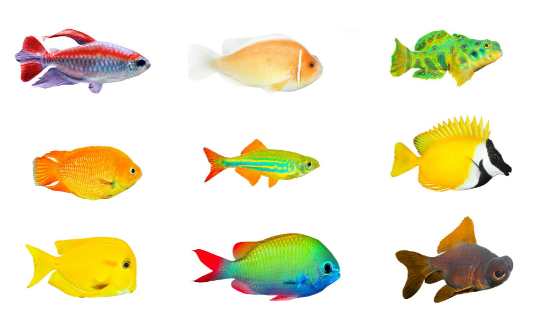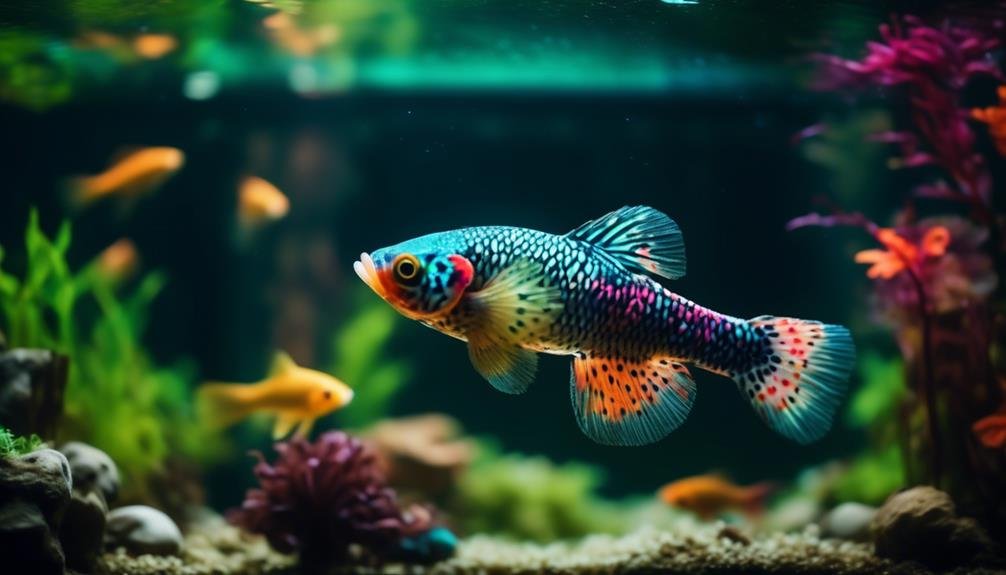
By chance, have you ever stumbled upon the fascinating world of killifish? These hardy fish breeds are not only visually stunning with their vibrant colors, but they also offer a unique and captivating experience for any aquarium enthusiast.
But where do these colorful creatures come from, and what do they require to thrive in your care? In this discussion, we will explore the origins of killifish and provide you with valuable tips on their care.
Get ready to dive into the world of killifish and uncover the secrets to keeping these resilient beauties happy and healthy in your own aquarium.
Key Takeaways
- Killifish are a diverse family of freshwater fish with over a thousand species, originating from various regions around the world.
- They come in a variety of vibrant colors and can range in temperament from community-friendly to aggressive.
- Killifish are hardy and adaptable to different water conditions, but they prefer subdued lighting and heavily planted aquariums.
- Suitable tank mates for killifish include tetras and other peaceful community fish, and their diet should consist of a variety of flake foods and live foods for optimal health and growth.
General Information About Killifish
Killifish, a diverse family of freshwater fish, are known for their hardiness and range of temperaments. With over a thousand different species, they offer a wide variety of options for fish enthusiasts. These small fish, typically reaching a length of 6 inches, can be kept in small aquariums, with a recommended size of 10 gallons.
Killifish originate from regions all over the world, including North America, Central America, South America, Africa, and Eurasia. They come in vibrant colors and can adapt to different water conditions. To create a suitable habitat, provide subdued lighting and a heavily planted aquarium. Keep in mind that killifish are jumpers, so it’s crucial to securely cover the tank with an overhead lid.
Origins and Care of Killifish
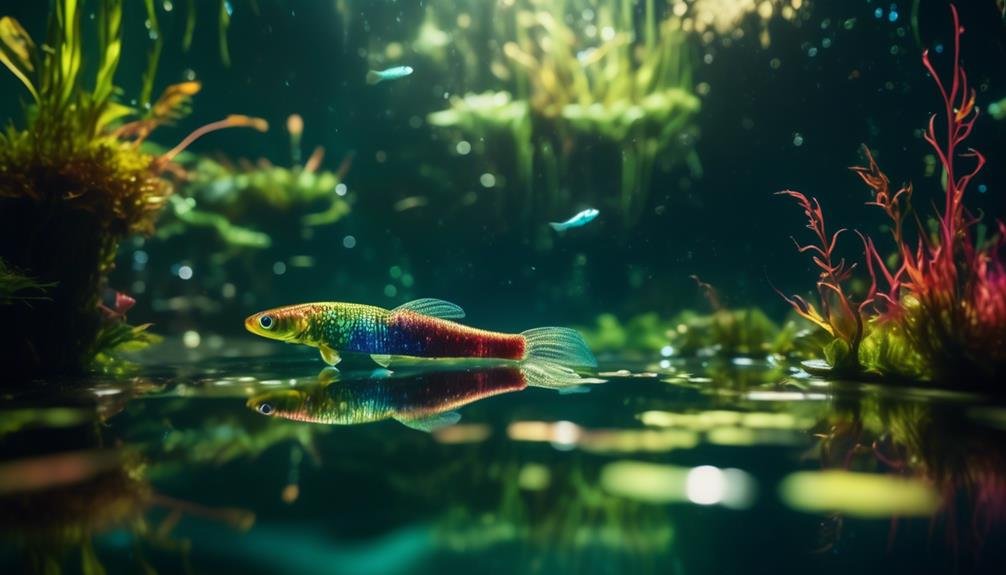
When considering the origins and care of killifish, it’s important to understand their natural habitats and the specific care requirements they need to thrive in captivity.
Killifish originate from various regions of the world, including North America, Central America, South America, Africa, and Eurasia. They come in a variety of vibrant colors.
Killifish are hardy and can adapt to different water conditions. They prefer subdued lighting and a heavily planted aquarium. Smaller tanks accumulate toxins faster, so it’s important to use a small box type filter or sponge filter. Additionally, killifish are known to be jumpers, so it’s crucial to securely cover the tank with an overhead lid.
Suitable tank mates for killifish include Cardinal Tetras, Neon Tetras, and Rummy Nose Tetras. Other peaceful community fish can also be compatible, depending on the specific species of killifish.
Understanding the origins and care requirements of killifish will help ensure their well-being and create an ideal environment for them to thrive in captivity.
Suitable Tank Mates for Killifish
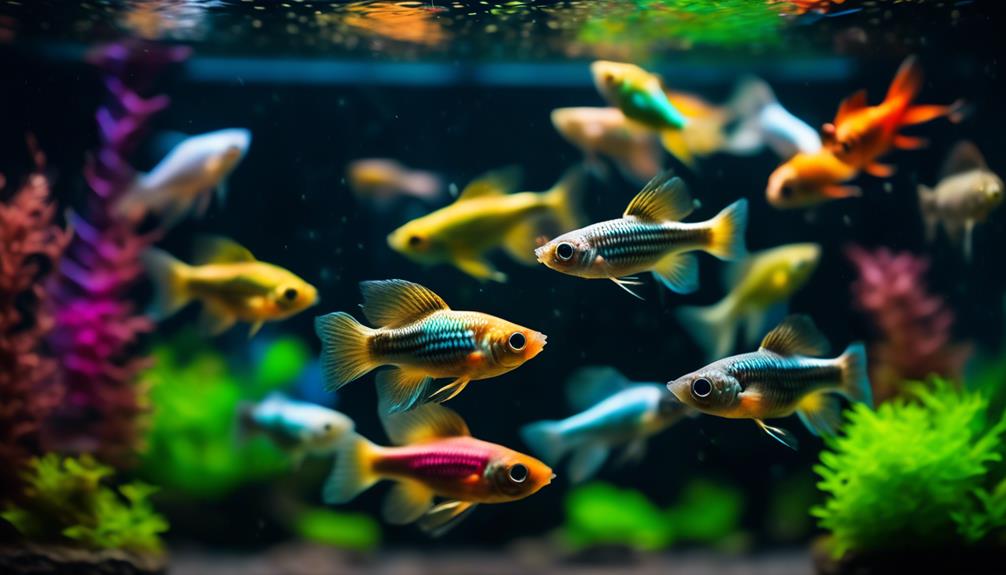
To ensure a harmonious community in your aquarium, it’s important to choose suitable tank mates for your killifish. Cardinal Tetras, Neon Tetras, and Rummy Nose Tetras are all excellent choices. These peaceful community fish are compatible with most species of killifish.
However, it’s important to consider the temperament and size of your killifish when selecting tank mates. Avoid aggressive or territorial fish that may harass or harm the killifish. Additionally, keep in mind the size of your aquarium and the specific needs of each species.
Providing plenty of hiding places and visual barriers can help reduce aggression and promote a peaceful environment for all your fish.
Feeding Killifish
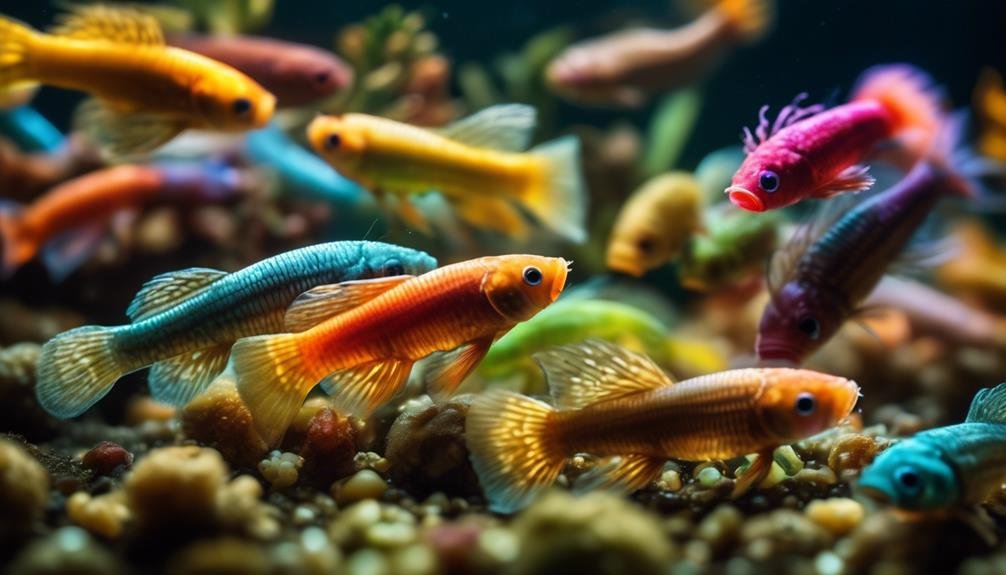
Feeding killifish is essential for their overall health and well-being. To ensure that your killifish are getting the proper nutrition, here are three important tips to keep in mind:
- Offer a variety of foods: While killifish readily accept flake type foods, it’s important to supplement their diet with live foods. Adding brine shrimp, daphnia, mosquito larvae, and other live foods will provide them with essential nutrients and mimic their natural feeding habits.
- Maintain a balanced diet: Variety in the diet is crucial for the overall health of killifish. By offering a mix of live foods and high-quality flake foods, you can ensure that they’re receiving a well-rounded diet that promotes growth and development.
- Adjust feeding frequency: The feeding frequency for killifish will vary depending on the species and individual needs. Observe their behavior and adjust the feeding schedule accordingly to prevent overfeeding or underfeeding.
Breeding Killifish
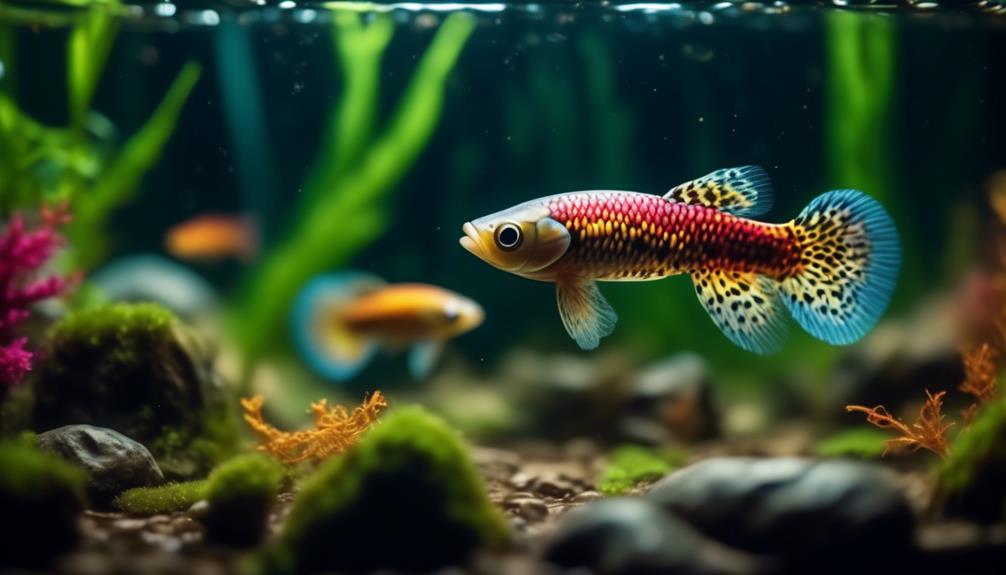
Breeding killifish requires understanding their specific spawning methods and providing suitable conditions in a breeding tank. Different species of killifish have different spawning methods, such as plant spawning or gravel spawning. It’s important to identify the spawning behavior of your specific killifish before setting up a breeding tank.
Some killifish eggs require a period of dry incubation before hatching, so it’s crucial to research the specific needs of your killifish species. To prevent the eggs from being eaten by other killifish, it’s necessary to harvest the eggs or remove the parent fish from the tank.
Once the fry hatch, they can be fed on baby brine shrimp, infusoria, or micro worms until they’re large enough to accept crushed flakes.
Best Tank Size for Killifish
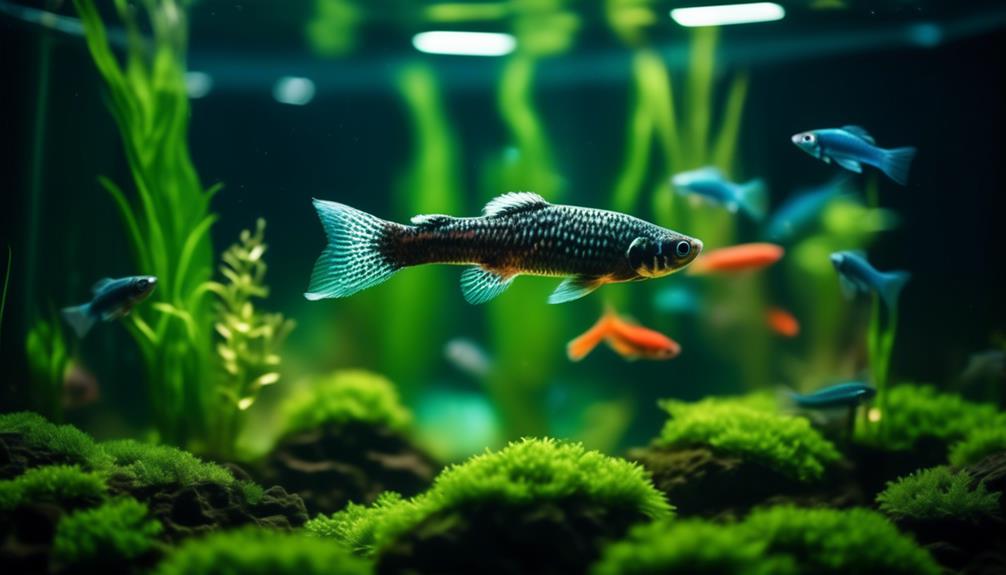
Understanding the specific needs of your killifish includes considering the best tank size for these hardy fish breeds. The right tank size is crucial for maintaining a healthy and thriving environment for your killifish. Here are three key factors to consider when determining the best tank size for your killifish:
- Space requirements: Killifish are active swimmers and need ample space to move around. A larger tank will provide them with more room to explore and exhibit their natural behaviors.
- Compatibility with tank mates: If you plan on keeping other fish species along with your killifish, a larger tank will help ensure that there’s enough space for everyone to coexist peacefully.
- Water quality maintenance: A bigger tank provides a larger volume of water, which can help maintain more stable water parameters. This is particularly important for killifish, as they’re sensitive to fluctuations in water conditions.
Water Conditions for Killifish
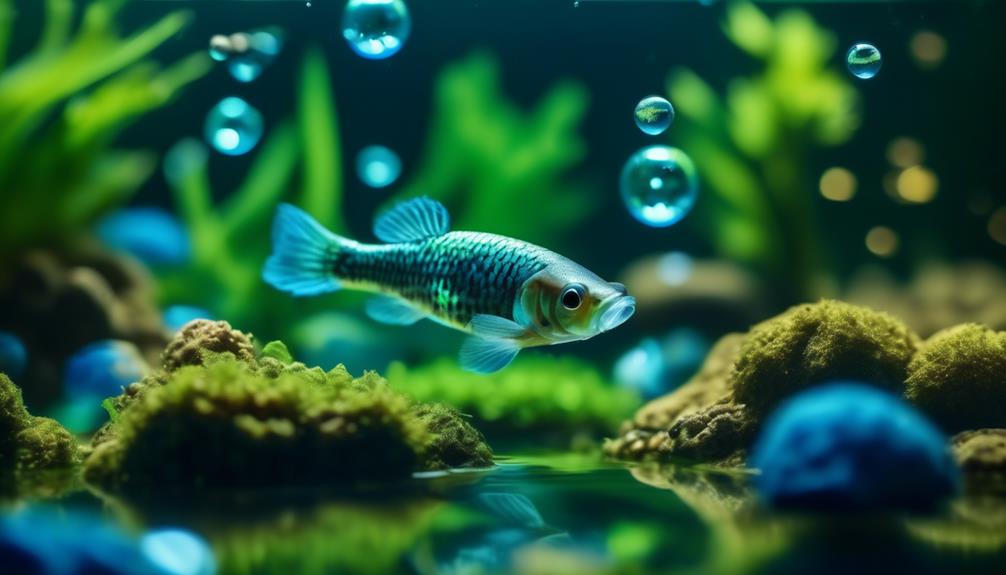
To ensure the health and well-being of your killifish, it’s crucial to maintain the proper water conditions in their tank. Killifish are adaptable, but there are specific parameters that you should aim for to create an optimal environment for them.
The temperature of the water should be between 72-75°F (22-24°C), with a pH level ranging from 6.0 to 7.5. It’s important to provide clean, well-filtered water to remove any toxins or impurities. Additionally, killifish prefer slightly acidic to neutral water.
Regular water changes are essential to maintain good water quality and prevent the build-up of harmful substances. Remember to monitor the water parameters regularly using a test kit to ensure that they remain within the appropriate range for your killifish.
Lighting Requirements for Killifish
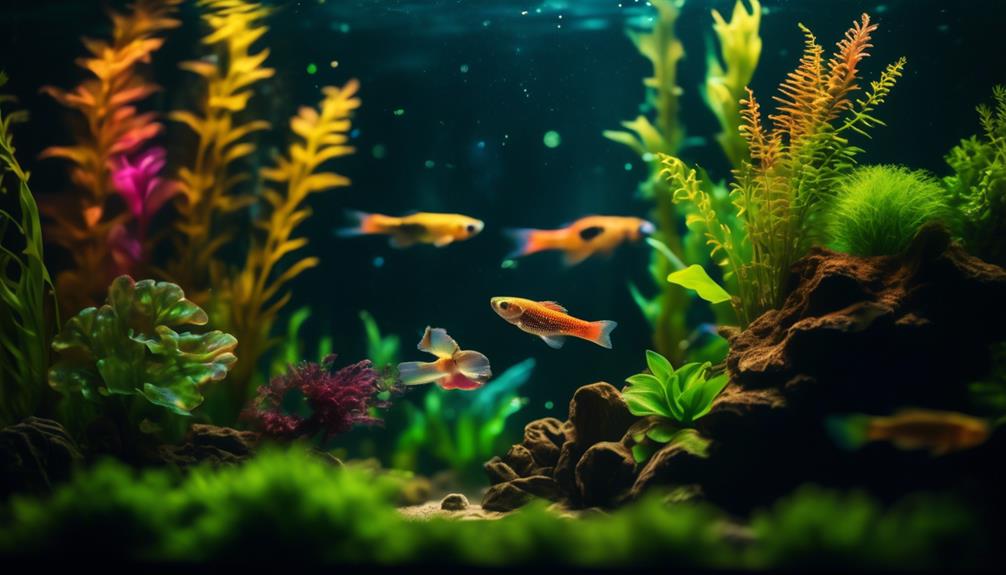
Killifish have specific lighting requirements that are important for their overall health and well-being. Here are three key considerations for lighting your killifish tank:
- Light Intensity: Killifish prefer subdued lighting, as they come from habitats with dense vegetation and shaded areas. Use low to moderate intensity lighting to replicate their natural environment and provide them with a sense of security.
- Light Duration: Killifish thrive on a consistent lighting schedule. Aim for 10-12 hours of light per day, followed by a period of darkness. This mimics their natural day and night cycle and helps regulate their behavior and biological processes.
- Light Spectrum: Opt for full-spectrum lights that emit a wide range of wavelengths, including both cool and warm spectrums. This ensures that your killifish receive the necessary light for photosynthesis and enhances their coloration.
Filtration Options for Killifish Tanks
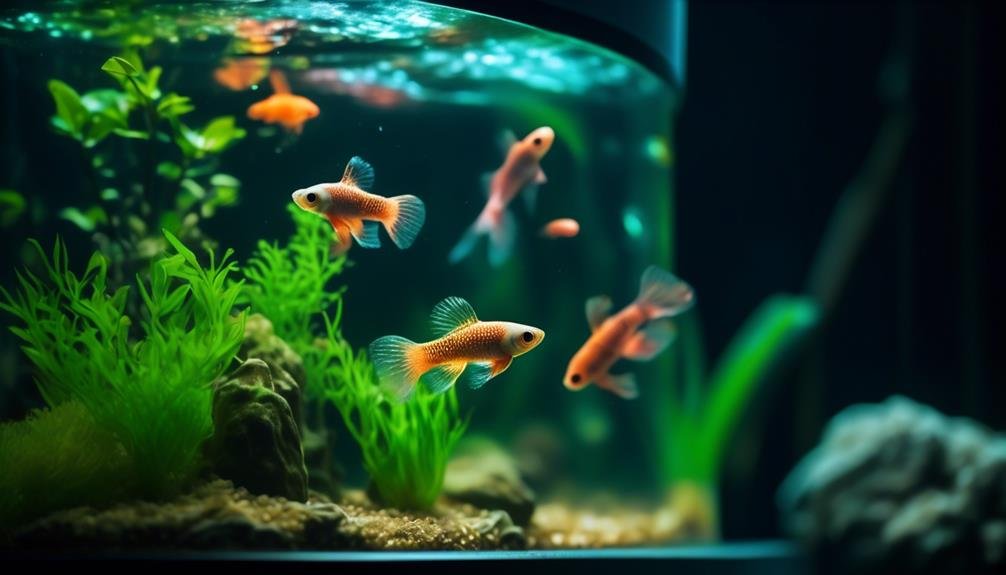
When setting up a tank for killifish, it’s important to consider the different filtration options available. Killifish are hardy fish that can adapt to different water conditions, but proper filtration is still essential for maintaining their health and well-being.
There are several filtration options to choose from, including sponge filters, box filters, and canister filters. Sponge filters are a popular choice for killifish tanks, as they provide mechanical and biological filtration while also creating gentle water movement.
Box filters are another option, which can be filled with filter media such as activated carbon or ceramic rings. Canister filters are more powerful and efficient, suitable for larger tanks or if you have a heavily stocked killifish aquarium.
Whichever filtration option you choose, make sure to regularly clean and maintain the filter to keep the water clean and clear for your killifish.
Preventing Jumping and Escaping
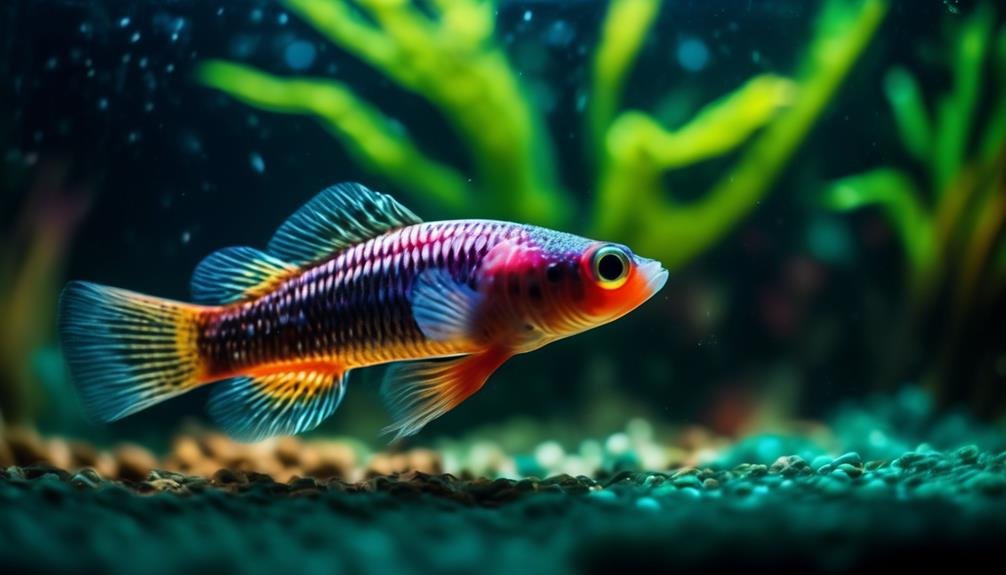
If you’re keeping killifish in your tank, it’s crucial to take measures to prevent them from jumping and escaping. Killifish are known for their jumping abilities, and without proper precautions, they can easily escape from an uncovered tank.
Here are three ways to prevent jumping and escaping:
- Cover the tank with a lid: Use an overhead lid that securely fits the tank to prevent killifish from jumping out. Make sure there are no gaps or openings that they can squeeze through.
- Reduce stress factors: Keep the tank environment calm and stress-free to minimize the chances of killifish attempting to jump. Avoid sudden movements or loud noises near the tank.
- Maintain water quality: Poor water conditions can lead to stress, which may increase the likelihood of jumping. Regularly monitor and maintain water parameters, including temperature, pH, and ammonia levels, to ensure a healthy and stable environment for your killifish.
Introducing Killifish to a New Tank
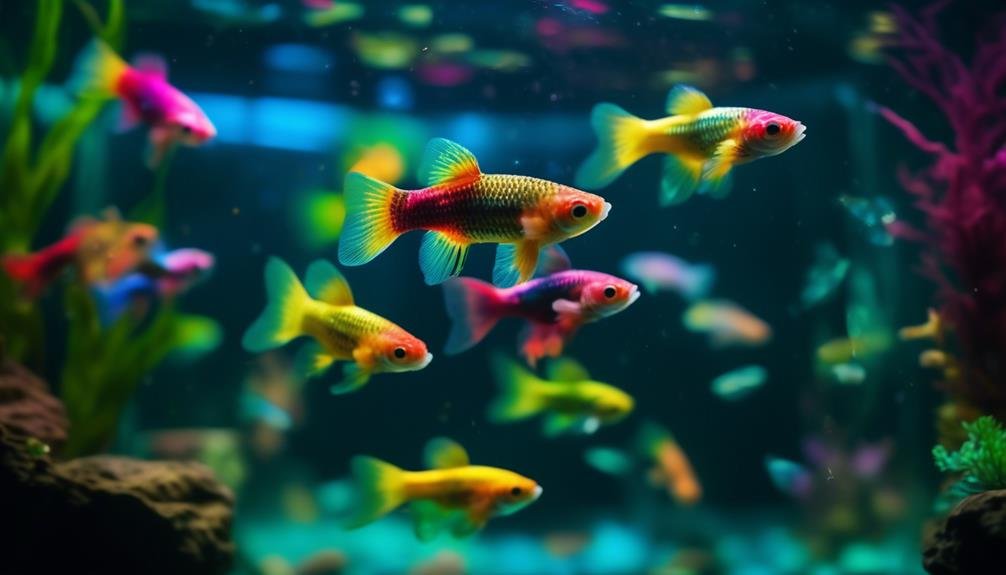
To successfully introduce killifish to a new tank, it’s important to acclimate them gradually to their new environment.
Start by floating the bag with the killifish in the tank for about 15 minutes, allowing the water temperatures to equalize.
Then, open the bag and add small amounts of tank water to it every 5 minutes for the next 30 minutes. This will help the killifish adjust to the water chemistry in the tank.
After 30 minutes, gently release the killifish into the tank, ensuring that they’ve plenty of hiding places and plants to explore.
Avoid sudden changes in water conditions or introducing them to a tank with aggressive tank mates.
Common Diseases and Health Issues in Killifish
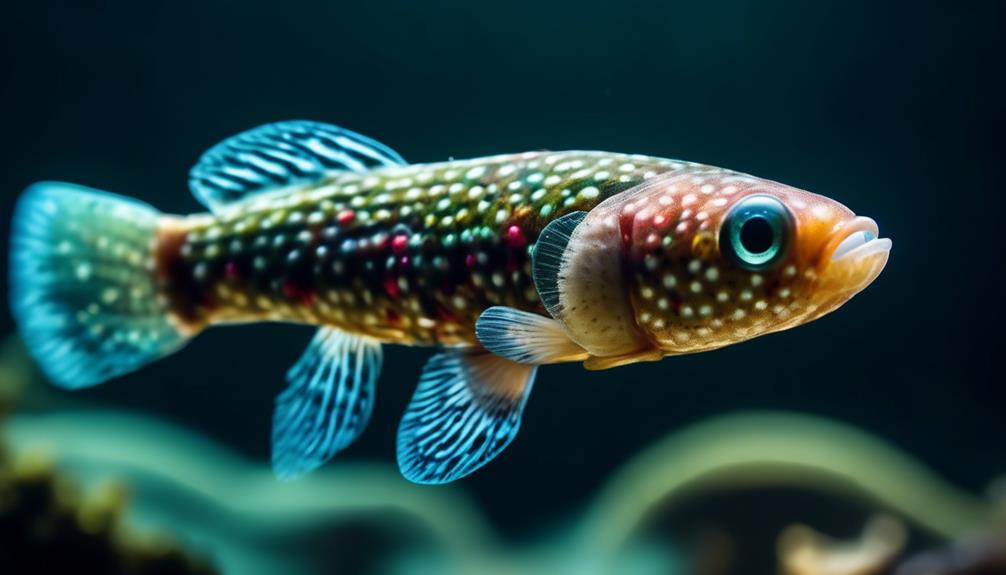
Common diseases and health issues can affect the well-being of killifish, requiring proper care and attention from their owners.
Here are three common diseases and health issues that you should be aware of:
- Ich (White Spot Disease): This is a parasitic infection characterized by small white spots on the fish’s body and fins. It can cause itching, scratching, and loss of appetite. Treatment options include increasing the water temperature and using medications specifically designed to treat Ich.
- Fin Rot: Fin rot is a bacterial infection that causes the fins and tail to become frayed, ragged, and discolored. It’s often caused by poor water quality or stress. Treating fin rot involves improving water conditions, maintaining good hygiene, and using antibiotics if necessary.
- Dropsy: Dropsy is a condition where the fish’s body swells, and scales may stick out like a pinecone. It’s usually caused by bacterial infection or organ failure. Treatment options may include isolating the affected fish, improving water quality, and using antibiotics if recommended by a veterinarian.
Proper Handling and Acclimation of Killifish
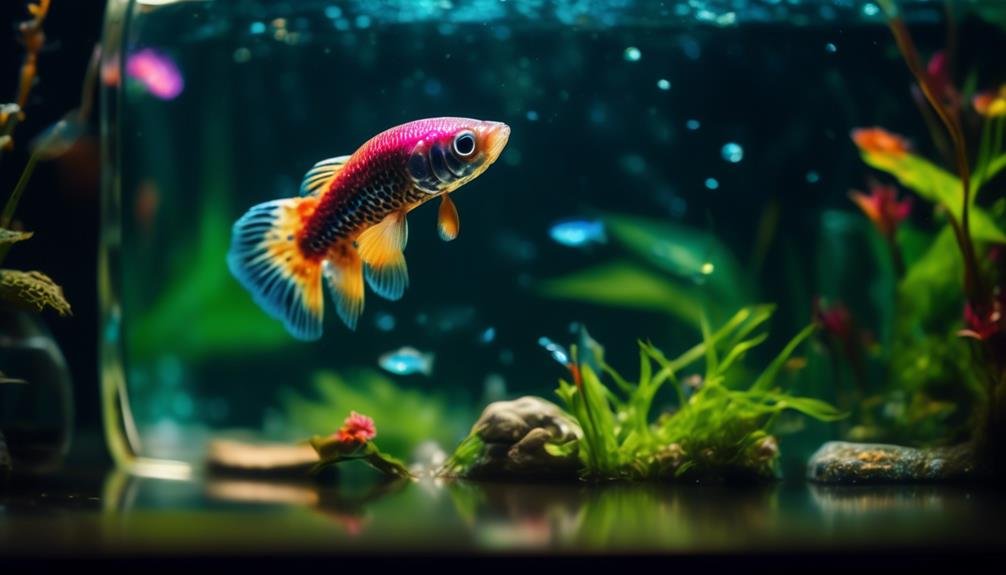
When handling and acclimating killifish, it’s important to follow proper procedures to ensure their well-being and minimize stress. To begin, make sure to wash your hands thoroughly before handling the fish to avoid introducing any harmful substances into their environment.
When transferring killifish from their transport bag to the aquarium, use a small net with soft mesh to gently scoop them out. Avoid using your hands as this can damage their delicate fins.
Once in the aquarium, it’s crucial to acclimate them slowly to the new water conditions. Float the sealed bag in the aquarium for about 15-20 minutes to allow the temperature to equalize. Then, open the bag and add a small amount of aquarium water every few minutes until the bag is full.
Finally, carefully release the killifish into their new home and observe them closely to ensure they’re adjusting well.
Following these steps will help ensure the successful handling and acclimation of your killifish.
Tips for Maintaining a Healthy Killifish Tank
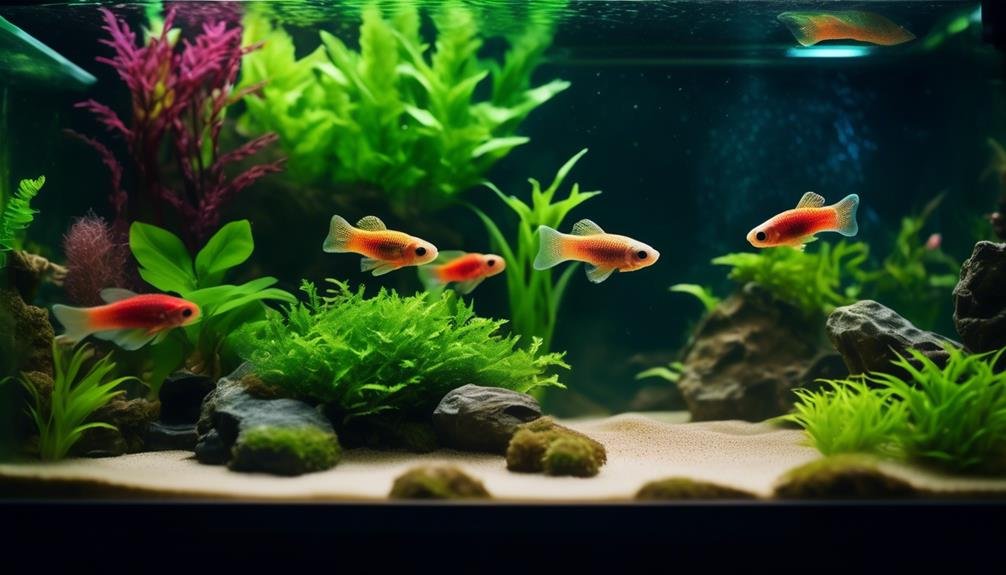
Maintaining a healthy killifish tank starts with proper care and attention to their environment. To ensure the well-being of your killifish, here are three important tips to follow:
- Water Quality: Killifish are sensitive to water conditions, so it’s crucial to maintain excellent water quality. Regularly test the water parameters such as pH, ammonia, nitrite, and nitrate levels. Perform regular water changes to keep the tank clean and remove any excess waste or toxins.
- Proper Filtration: Invest in a good filtration system that can effectively remove impurities and provide adequate oxygenation. Consider using a small box type filter or a sponge filter for smaller tanks. Ensure the filter is properly maintained and cleaned to prevent any buildup of debris or harmful substances.
- Suitable Tankmates: Choose compatible tankmates that won’t harm or stress your killifish. Cardinal Tetras, Neon Tetras, and Rummy Nose Tetras are known to be suitable companions. Remember to research the specific species of killifish and their preferred tank mates to create a harmonious community.
Fun Facts and Interesting Trivia About Killifish
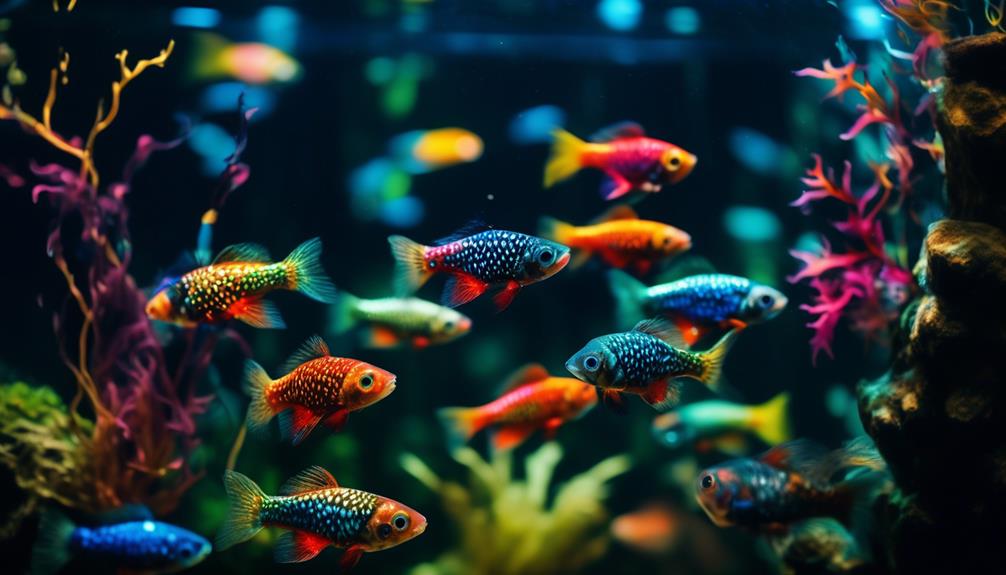
Did you know that killifish have the unique ability to survive in temporary bodies of water by entering a state of suspended animation called diapause? During this period, the fish can withstand extreme conditions such as drought and lack of oxygen. Here are some fascinating facts and trivia about killifish:
| Fun Fact | Description |
|---|---|
| Colorful Varieties | Killifish come in a stunning array of vibrant colors, making them a popular choice among aquarium hobbyists. From bright reds and blues to striking patterns, these fish are a sight to behold. |
| Jumping Abilities | Killifish are known for their impressive jumping abilities. They can leap out of the water to catch insects or escape from predators. It is important to securely cover the tank to prevent them from jumping out. |
| Short Lifespan | Unlike other fish species, killifish have relatively short lifespans ranging from a few months to a few years. This makes them an interesting choice for those looking for a unique and ever-changing aquarium experience. |
These fun facts and interesting trivia about killifish showcase the remarkable adaptability and captivating nature of these hardy fish.
Frequently Asked Questions
Can Killifish Be Kept in Outdoor Ponds?
Yes, killifish can be kept in outdoor ponds. They are hardy fish that can adapt to different water conditions. However, it is important to provide proper filtration, cover the pond to prevent escape, and protect them from predators.
How Long Does It Take for Killifish Eggs to Hatch?
Killifish eggs typically take around 2-4 weeks to hatch, depending on the specific species. It’s important to monitor water conditions and provide the right environment for successful hatching.
Are There Any Specific Water Parameters That Killifish Require?
Killifish require specific water parameters for optimal health. These include a temperature range of 72-75 degrees Fahrenheit, pH level of 6.5-7.5, and water hardness of 5-15 dGH. Regular water testing and maintenance are essential.
Can Killifish Be Kept With Aggressive or Territorial Fish Species?
Yes, killifish can be kept with peaceful community fish like tetras, but it’s not recommended to keep them with aggressive or territorial fish species to ensure the safety and well-being of all the fish.
Do Killifish Require a Specific Type of Substrate in Their Tank?
No, killifish do not require a specific type of substrate in their tank. They can adapt to different types of substrate, such as gravel or sand. Just make sure it is clean and doesn’t contain any harmful chemicals.
Can Killifish and Gar Fish Coexist in the Same Tank?
While Killifish are peaceful community tank inhabitants, the killer instincts of gar fish may pose a challenge in coexisting. Due to their predatory nature, gar fish may see smaller fish like Killifish as potential prey. It’s best to keep them in separate tanks to avoid any potential conflict.
Conclusion
So now you have delved into the vibrant and captivating world of killifish!
These hardy freshwater fish breeds offer a stunning array of colors and temperaments that are sure to captivate any fish enthusiast.
From their origins to their specific care requirements, you have learned how to provide a suitable and thriving environment for your killifish.
Remember to choose suitable tank mates, provide proper nutrition, and follow the unique breeding methods to ensure a successful and enjoyable experience with these beautiful fish.




